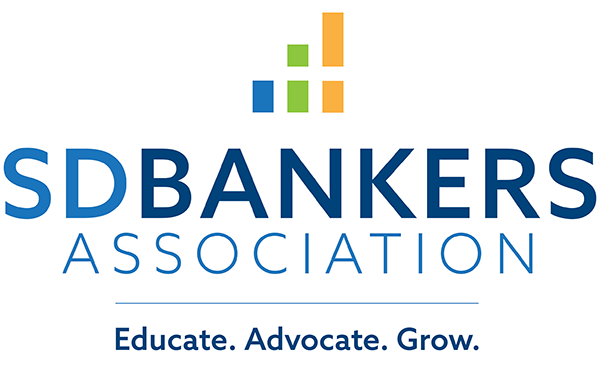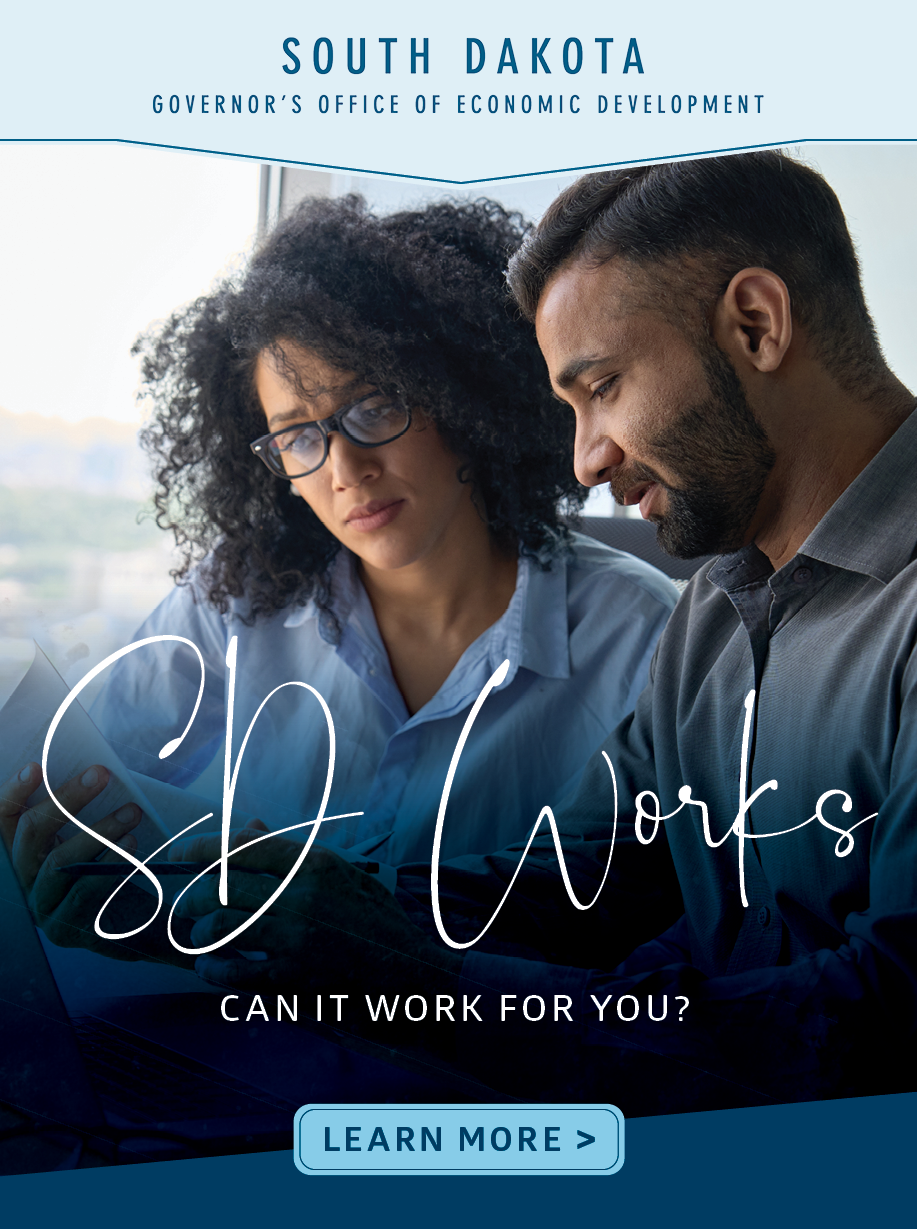- Education & Events
- Advocacy
- Products & Services
- Membership
- Resources
- SDBANKER Magazine
- SDBA eNews
- SDBA eNews Archives
- Legislative Update/Bill Watch
- South Dakota Bank Directory
- Women in Banking
- Scenes of South Dakota Calendar*
- Holiday Signs
- Regulatory Report
- South Dakota Banking Code
- Record Retention Manual
- Advertising & Sponsorship Guide
- COVID-19 Resources
- Mental Health and Crisis Prevention
- About
|
Early-Bird Registration Deadline for NEXT STEP: Emerging Leader's Summit Ends Tomorrow!Last Chance to Order Your 2024 Scenes of South Dakota Calendars!The SDBA is still taking orders for the 2024 Scenes of South Dakota Calendar until Monday, September 18! This calendar features photos of South Dakota submitted by South Dakota bankers, their family members and customers. These calendars are a great opportunity to thank your customers for their business and promote your bank or business. Your bank, branch or business' logo and name can be printed on each calendar to display in homes and businesses all year long. The SDBA logo is also included to emphasize the strength and security of South Dakota’s banking industry. The Scenes of South Dakota Calendar is exclusive to SDBA member banks and associate members. Place your order here for the 2024 Scenes of South Dakota Calendar! If you have any questions, email Haley Juhnke or call the SDBA Office at 800.726.7322. Register for SDBA's Annual Security Seminar | October 19, Sioux FallsThe SDBA is hosting the Annual Security Seminar on Thursday, October 19, at the Best Western PLUS Ramkota Hotel and Conference Center in Sioux Falls. This well-rounded seminar focuses on a range of issues of concern to security officers, facility personnel, and management. Using current trends and examples, a variety of topics will be covered: National Security Update | AI: What is Ahead Active Shooter: The Warning Signs Conducting a Physical Security Review and Risk Assessment Focus Group and Case Studies Internal Fraud: A Look at the Thieves from Within Security officers or directors, operations managers, auditors, HR directors, legal staff, loan officers, disaster recovery managers, collection staff and fraud investigators would all benefit from attending the Security Seminar. For more information and to register, click here. Judge Grants Win to ABA, Chamber in Lawsuit Over CFPB UDAAP Exam ManualAs reported in a special edition on Friday night, a federal judge in Texas granted summary judgment to ABA, the Texas Bankers Association, the U.S. Chamber of Commerce and several other co-plaintiffs in their challenge to the CFPB’s UDAAP exam manual. In a sharp rebuke of the agency, the judge issued a final judgment setting aside the CFPB’s March 2022 interpretation of its UDAAP authority. The court granted additional protection to the plaintiffs’ members by issuing a final judgment prohibiting the CFPB from “pursuing any examination, supervision, or enforcement action against any member of a plaintiff organization based on the CFPB’s interpretation of its UDAAP authority.” The judge agreed with ABA that the CFPB clearly exceeded its statutory authority under the Dodd-Frank Act. In addition, the judge upheld ABA’s challenge to the exam manual on the grounds that it was the product of an unconstitutionally funded agency. (Texas is covered by an appellate court ruling, currently being appealed to the Supreme Court, that found the bureau’s funding violates the Appropriations Clause of the Constitution.) While ABA repudiates discrimination of any kind, it argued in the case that the bureau’s unfair, deceptive and abusive acts or practices, or UDAAP, authority cannot be used to extend the fair lending laws beyond the bounds set by Congress. “We strongly support the fair enforcement of nondiscrimination laws, but the bureau’s extraordinary expansion of its regulatory reach crossed the line,” ABA President and CEO Rob Nichols said. “We hope this ruling sends a clear message to the bureau and all federal regulators that they must operate within the boundaries set by Congress.” Read ABA’s statement. Read the court ruling. Bank Economists: “Soft Landing” Odds Have Improved But Recession Risks RemainDespite an expected loss of momentum in U.S. economic growth over the next few quarters, the U.S. economy is likely to dodge a recession, according to the latest forecast of the American Bankers Association’s Economic Advisory Committee. The committee, composed of 14 chief economists from some of North America’s largest banks, sees real economic growth slowing from 2.1% annualized during the first three quarters of 2023 to less than 1.0% annualized over the following three quarters. Momentum then improves slightly in the latter part of 2024, although the pace of activity remains below potential, according to the committee. While the median committee forecast does not include any quarterly contractions, considerable concerns about a mild recession remain. Recession risks center primarily around the delayed impact of monetary tightening, deteriorating credit availability, and high credit costs, but also include event risks such as a prolonged government shutdown or renewed flaring of geopolitical tensions. The group consensus is that near-term recession risks have come down but are still significant for 2024, approaching 50%. Consistent with slowing growth, the group expects various measures of inflation to ease close to the Federal Reserve’s target. The committee’s forecast is that consumer inflation will decline from around 4% annualized over 2023 to just above 2% in 2024. “The odds of the Fed achieving a soft landing look much better today than they did six months ago,” said Simona Mocuta, committee chair and chief economist at State Street Global Advisors. “However, the battle against inflation is not yet won, so the Fed must remain vigilant. At the same time, there is a better balance between supply and demand across the board, in goods, services and labor markets. This helps the ongoing disinflation process.” The group noted that household spending has been supported by robust employment gains and an improvement in real disposable income. However, this resilience will fade amid the high cost of credit, the exhaustion of excess savings and weaker job growth. Business investment is also set to slow, although pockets of strength exist, particularly in areas of the economy benefitting from government policy initiatives such as chips and EV manufacturing. Businesses have been preparing for a general economic slowdown by reducing inventory accumulation and hiring. Profit margins are expected to remain under pressure from rising labor costs, tightening credit availability and diminishing pricing power. Bank chief economists see evidence of modest labor market easing. The pace of anticipated job creation slows from over 200,000 per month in 2023 to just about 70,000 in 2024. Wage inflation—currently too high to be consistent with the 2.0% inflation target—moderates further as a result. The committee sees the unemployment rate rising to 4.4% by the end of 2024. The consensus view of the committee is that the Federal Reserve will leave the target federal funds rate range unchanged until next May, then reduce it by 100 basis points before the end of 2024. “Given both demonstrated and anticipated progress on inflation, the majority of the committee members believe that the Fed’s tightening cycle has run its course,” said Mocuta. The committee expects 10-year Treasury yields to slip back from over 4% at present to near 3.6% at the end of next year, and 30-year mortgage rates to retreat from near 8% to near 6% over the same period. Following six consecutive quarterly declines, the committee sees residential investment bottoming out and improving slightly through 2024. However, the group foresees a modest correction in home prices on a national average basis until the fourth quarter of 2024, when prices will begin to recover. “After a dramatic decline, things have stabilized in housing,” said Mocuta. “Despite high mortgage rates, the demand is there.” View detailed EAC forecast numbers. The 2023 ABA Economic Advisory Committee includes: EAC Chair Simona Mocuta, chief economist, State Street Global Advisors, Boston; Bill Adams, SVP and chief economist, Comerica Bank, Dallas; Scott Anderson, managing director and chief U.S. economist, BMO, San Francisco; Beth Ann Bovino, chief economist, U.S. Bank, Brooklyn, N.Y.; Beata Caranci, SVP and chief economist, TD Bank Group, Toronto; Augustine Faucher, SVP and chief economist, PNC Financial Services Group, Pittsburgh; Peter Hooper, managing director and vice chair of research, Deutsche Bank, New York; Tendayi Kapfidze, managing director and chief corporate economist, Wells Fargo & Co., New York; Bruce Kasman, managing director and chief economist, JPMorgan Chase & Co., New York; Christopher Low, chief economist, First Horizon National Corp’s FTN Financial, New York; Richard Moody, SVP and chief economist, Regions Bank, Birmingham, Ala.; Carl Tannenbaum, EVP and chief economist, The Northern Trust Company, Chicago; Luke Tilley, executive vice president and chief economist, Wilmington Trust Investment Advisors, Wayne, Pa.; and Ellen Zentner, managing director and chief U.S. economist, Morgan Stanley, New York.
New ABA Report: 88% of Banks Report Active Social Media EngagementNine in 10 banks (89%) believe social media is important to their banks and 88% are very or somewhat active on their social media accounts, according to a new report released today by the American Bankers Association. The State of Social Media in Banking 2023 highlights the results of an ABA survey of 330 banks of all sizes. The survey measures how banks are managing social media programs, what results they are getting, what they wish they could do better, and what opportunities and challenges are on the horizon. “This report shows that social media serves as an essential marketing channel that allows banks to connect with customers by meeting them where they are,” said Russell Davis, ABA’s executive vice president of member engagement. “When used effectively, social media helps banks humanize their brand and build relationships while offering a strong return on investment.” Banks’ most preferred platforms are Facebook (95%), LinkedIn (75%) and Instagram (62%), followed by X (formerly known as Twitter) (41%), YouTube (39%) and blogs (19%). Banks’ top uses for social media include communication (89%), recruiting (75%), financial education (71%), marketing and sales (59%), and customer service (57%). In addition, the survey found that half of respondents (50%) planned to increase spending on social media resources in 2023 while 44% were planning to hold their budget steady and less than 1% planned to decrease social media budgets. The report also identifies which social media platforms banks use for marketing purposes as well as profiling how different banks across the country are using social media to generate tangible results. It culminates with a list of 10 top takeaways for banks evaluating their use of social media. To download a copy of the report, visit aba.com/SocialMediaSurvey.
CISA News: Artificial IntelligenceCISA held a webinar on the fundamentals of AI last week. Slides are linked below, along with a good overview article.
|



